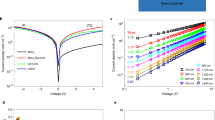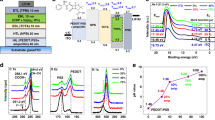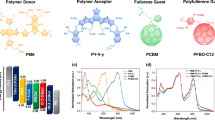Abstract
Organic light-emitting diodes (OLEDs) represent a promising technology for large, flexible, lightweight, flat-panel displays1,2,3. Such devices consist of one or several semiconducting organic layer(s) sandwiched between two electrodes. When an electric field is applied, electrons are injected by the cathode into the lowest unoccupied molecular orbital of the adjacent molecules (simultaneously, holes are injected by the anode into the highest occupied molecular orbital). The two types of carriers migrate towards each other and a fraction of them recombine to form excitons, some of which decay radiatively to the ground state by spontaneous emission. Doped π-conjugated polymer layers improve the injection of holes in OLED devices4,5,6,7,8,9; this is thought to result from the more favourable work function of these injection layers compared with the more commonly used layer material (indium tin oxide). Here we demonstrate that by increasing the doping level of such polymers, the barrier to hole injection can be continuously reduced. The use of combinatorial devices allows us to quickly screen for the optimum doping level. We apply this concept in OLED devices with hole-limited electroluminescence (such as polyfluorene-based systems10,11,12), finding that it is possible to significantly reduce the operating voltage while improving the light output and efficiency.
This is a preview of subscription content, access via your institution
Access options
Subscribe to this journal
Receive 51 print issues and online access
$199.00 per year
only $3.90 per issue
Buy this article
- Purchase on Springer Link
- Instant access to full article PDF
Prices may be subject to local taxes which are calculated during checkout




Similar content being viewed by others
References
Friend, R. H. et al. Electroluminescence in conjugated polymers. Nature 397, 121–128 (1999).
Heeger, A. J. Light emission from semiconducting polymers: light-emitting diodes, light-emitting electrochemical cells, lasers and white light for the future. Solid State Commun. 107, 673–679 (1998).
Salbeck, J. Electroluminescence with organic compounds. Ber. Bunsenges. Phys. Chem. 100, 1667–1677 (1996).
Gustafsson, G. et al. Flexible light-emitting diodes made from soluble conducting polymers. Nature 357, 477–479 (1992).
Yang, Y. & Heeger, A. J. Polyaniline as a transparent electrode for light-emitting diodes: Lower operating voltage and higher efficiency. Appl. Phys. Lett. 64, 1245–1247 (1994).
Gao, J., Heeger, A. J., Lee, Y. J. & Kim, C. Y. Soluble polypyrrole as the transparent anode in polymer light-emitting diodes. Synth. Met. 82, 211–223 (1996).
Carter, S. A., Angelopoulos, M., Karg, S., Brock, P. J. & Scott, J. C. Polymeric anodes for improved polymer light-emitting diode performance. Appl. Phys. Lett. 70, 2067–2069 (1997).
Scott, J. C., Carter, S. A., Karg, S. et al. Angelopoulos, M. Polymeric anodes for light-emitting diodes. Synth. Met. 85, 1197–1200 (1997).
Cao, Y., Yu, G., Zhang, C., Menon, R. & Heeger, A. J. Polymer light-emitting diodes with polyethylene dioxythiophene-polystyrene sulfonate as the transparent anode. Synth. Met. 87, 171–174 (1997).
Grice, A. W. et al. High brightness and efficient blue light-emitting polymer diodes. Appl. Phys. Lett. 73, 629–631 (1998).
Janiez, S. et al. Electrochemical determination of the ionization potential of poly(9,9-dioctylfluorene). Appl. Phys. Lett. 73, 2453–2455 (1998).
Grell, M. et al. Polarized electroluminescence from a liquid crystalline polyfluorene. Adv. Mater. 11, 671–674 (1999).
Nuesch, F., Rothberg, L. J., Forsythe, E. W., Quoc Toan, L. & Gao, Y. A. Photoelectron spectroscopy study on the indium tin oxide treatment by acids and bases. Appl. Phys. Lett. 74, 880–882 (1999).
Kim, J. S. et al. Indium tin oxide treatments for single and double layer polymeric light emitting diodes. The relation between the anode physical, chemical, and morphological properties and the device performance. J. Appl. Phys. 84, 6859–6870 (1998).
Skotheim, T. A. Handbook of Conducting Polymers (Dekker, New York, 1986).
Bard, A. J. & Faulkner, L. A. Electrochemical Methods—Fundamentals and Applications (Wiley, New York, 1984).
Xing, K. Z., Fahlman, M., Chen, X. W., Inganäs, O. & Salaneck, W. R. The electronic structure of poly(3,4-ethylene-dioxyghiophene): studied by XPS and UPS. Synth. Met. 89, 161–165 (1997).
Brown, T. M. et al. Built-in field electroabsorption spectroscopy of polymer light-emitting diodes incorporating a doped poly(3,4-ethylene dioxythiophene) hole injection layer. Appl. Phys. Lett. 75, 1679–1681 (1999).
Dietrich, M. & Heinze, J. Poly(4,4′-Dimethoxybithiophene)—A new conducting polymer with extraordinary redox and optical properties. Synth. Met. 41–43, 503–506 (1991).
Malliaras, G. G. & Scott, J. C. Numerical simulations of the electrical characteristics and the efficiencies of single-layer organic light emitting diodes. J. Appl. Phys. 85, 7426–7432 (1999).
Malliaras, G. G., Salem, J. R., Brock, P. J. & Scott, C. Electrical characteristics and efficiency of single-layer organic light-emitting diodes. Phys. Rev. B 58, R13411–R13414 (1998).
Acknowledgements
We thank J. Heinze for making some bithiophene available, W. Brütting for discussions, and Bayer AG (Leverkusen, Germany) for the donation of Baytron P.
Author information
Authors and Affiliations
Corresponding author
Rights and permissions
About this article
Cite this article
Gross, M., Müller, D., Nothofer, HG. et al. Improving the performance of doped π-conjugated polymers for use in organic light-emitting diodes. Nature 405, 661–665 (2000). https://doi.org/10.1038/35015037
Received:
Accepted:
Issue Date:
DOI: https://doi.org/10.1038/35015037
This article is cited by
-
Improved Stability and Spectral Photophysical Properties of poly (9, 9′-di-n-1 octylfluorenyl-2.7-diyl) /MgO Nanohybrid Films
Arabian Journal for Science and Engineering (2024)
-
Quasiparticle dynamics by effective \(\pi \)-field distortion
Scientific Reports (2022)
-
Conjugated Polymer Nanomaterials for Phototherapy of Cancer
Chemical Research in Chinese Universities (2020)
-
Recent advances in thermally activated delayed fluorescence for white OLEDs applications
Journal of Materials Science: Materials in Electronics (2020)
-
Analysis of ITO surface modified with aromatic-based self-assembled molecules
Bulletin of Materials Science (2020)
Comments
By submitting a comment you agree to abide by our Terms and Community Guidelines. If you find something abusive or that does not comply with our terms or guidelines please flag it as inappropriate.



